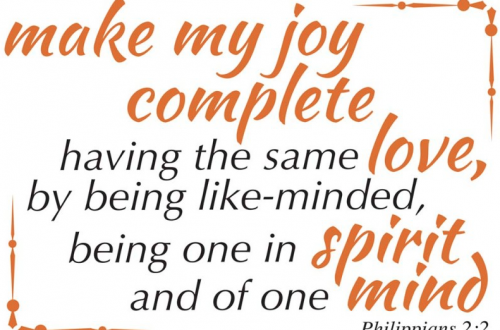
The Tabernacle of Moses – God’s Heavenly Pattern for our Spiritual Transformation – Part VI: The Priestly Garments
The purpose of this study is to review each of the three priestly garments of the Old Testament in detail.
- The High Priest’s year-round garment.
- The High Priest’s Day of Atonement garment.
- The Priest’s year-round garment.
And you, bring near to you your brother Aaron and his sons with him from among the Israelites, so that they may minister as my priests– Aaron, Nadab and Abihu, Eleazar and Ithamar, Aaron's sons. You must make holy garments for your brother Aaron, for glory and for beauty. You are to speak to all who are specially skilled, whom I have filled with the spirit of wisdom, so that they may make Aaron's garments to set him apart to minister as my priest. (Exodus 28:1-3 NET)
For Glory and Beauty, the garments bring praise to God and admiration from all that gaze upon them. This bespoke of custom-fitted, meticulously detailed, and immaculately clean garments.
The High Priest’s Year-Round Uniform
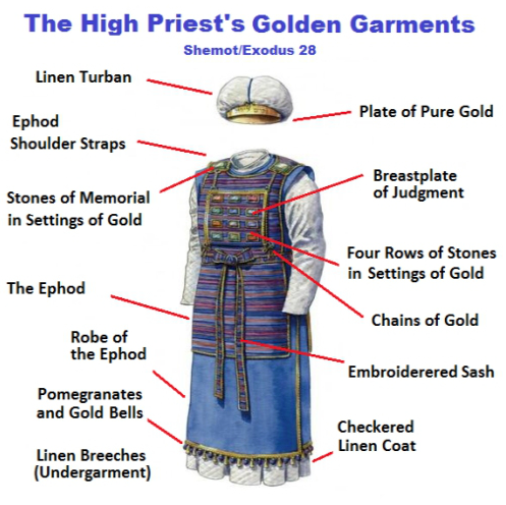
The High Priest was revered as much or more than any king or royalty of the nations around Israel. Consequently, these clothes carried the richness and beauty that surpassed the royal robes of the mightiest kings of the surrounding empires. The “Golden Garment” of the High Priest’s uniform was a two-layered set of clothing that included the four garments of the regular priests plus four additional articles of clothing that were added to enhance the ritual beauty and honor of the sacredness of the duties of the High Priest in his daily work of atonement for the children of Israel. The golden garments were worn all year in the rituals performed by the High Priest when he, in view of the people of Israel, enters the sanctuary interior in the morning and evening sacrifices.
The High Priest and Priests wore no shoes or sandals, meaning they would walk barefoot, which is the prerequisite for walking on holy ground (Exodus 3:5).
The first four articles of clothing were uniquely worn by the High Priest, and the last four garments were similar to those worn by the other Priests except the Sash, which was unique for the “Golden Garment”:
- Breastplate
- Ephod (Vest or Apron)
- Robe (Coat – Outer Garment)
- Plate (Diadem or Crown)
- Tunic (Long Shirt – Inner Garment)
- Turban (Hat or Mitre)
- Sash (Linen (1) Belt or Girdle)
- Undergarments (Short Pants)
Now these are the garments that they are to make: a breastpiece, an ephod, a robe, a fitted tunic, a turban, and a sash. They are to make holy garments for your brother Aaron and for his sons, that they may minister as my priests. The artisans are to use the gold, blue, purple, scarlet, and fine linen. (Exodus 28:4,5 NET)
From the blue, purple, and scarlet yarn, they made woven garments for serving in the sanctuary; they made holy garments that were for Aaron, just as the LORD had commanded Moses. (Exodus 39:1 NET)
"You are to present Aaron and his sons at the entrance of the tent of meeting. You are to wash them with water and take the garments and clothe Aaron with the tunic, the robe of the ephod, the ephod, and the breastpiece; you are to fasten the ephod on him by using the skillfully woven waistband. You are to put the turban on his head and put the holy diadem on the turban. You are to take the anointing oil and pour it on his head and anoint him. You are to present his sons and clothe them with tunics and wrap the sashes around Aaron and his sons and put headbands on them, and so the ministry of priesthood will belong to them by a perpetual ordinance. Thus you are to consecrate Aaron and his sons. (Exodus 29:4-9 NET)
Then he put the tunic on Aaron, wrapped the sash around him, and clothed him with the robe. Next he put the ephod on him and placed on him the decorated band of the ephod, and fastened the ephod closely to him with the band. He then set the breastpiece on him and put the Urim and Thummim into the breastpiece. Finally, he set the turban on his head and attached the gold plate, the holy diadem, to the front of the turban just as the LORD had commanded Moses. Then Moses took the anointing oil and anointed the tabernacle and everything in it, and so consecrated them. Next he sprinkled some of it on the altar seven times and so anointed the altar, all its vessels, and the wash basin and its stand to consecrate them. He then poured some of the anointing oil on the head of Aaron and anointed him to consecrate him. Moses also brought forward Aaron's sons, clothed them with tunics, wrapped sashes around them, and wrapped headbands on them just as the LORD had commanded Moses. (Leviticus 8:7-13)
Spiritual Significance:
Yarn and Thread Colors – Five Colors which is the Biblical Number for Grace.
Gold (pure) (1) – Almighty God who is Holy. Divinely Righteous.
Blue – Heaven, the abode of God. God’s divinity has come from Heaven. Jesus the Messiah! The color of Grace. The Gospel of John – Jesus the Son of God.
Red – Blood (1), the requirement for redemption that leads to righteousness. In Hebrew, “Dham” means blood, and “Adham” (i.e., Adam) means red-blooded man. Jesus came from Heaven to become a red-blooded man. (1 Corinthians 15:45-47) The Gospel of Mark – Jesus the suffering servant.
Purple – God’s Royal Blood in the Son of Man (Red) that came from Heaven (Blue). Red and blue combined yield purple. The Gospel of Matthew – Jesus of royal lineage.
White – Righteousness and purity. That is, right standing or rather the “right to stand” before our Holy God. The Gospel of Luke – Jesus the Son of Man.
The Golden Garments of the High Priest revealed Jesus as God the Great High Priest in Heaven. When the High Priest put on these garments, he was putting on Christ! It was as if “The Word” (i.e., Jesus) offered the animal sacrifices to God the Father.
1. Breastplate

Over the ephod, the High Priest wore a breastplate, a pouch about 22 cm (about 9 inches) square made of beautifully woven material. The Urim and Thummim were placed inside this pouch. The name Urim means “lights, ” while Thummim means “perfections.” On the front of the breastplate were fastened twelve precious stones in four rows of three. On each of these stones was engraved the name of one of the tribes of Israel. The breastplate was, in reality, a piece of elaborately finished cloth of the same material as the ephod. It was a strip twice as long as it was wide but folded back on itself to form a square bag into which the Urim and Thummim were placed. The breastplate was held in place by golden chains attached to the onyx shoulder clasps and blue lace ribbons, which attached the breastplate to the ephod. There must have been a small golden ring attached to each corner of the breastplate to which, in turn, the golden chains and ribbons were connected. The stones upon the breastplate represented the twelve tribes of Israel, and they were borne before the Lord continually as a memorial. Since the twelve stones were in one breastplate, they speak of the oneness of the people of God, while their position upon Aaron’s breast speaks of God’s affection for His people. The names on the breastplate were always close to Aaron’s heart, just like Christ and His precious ones. The Bible instructs that each thread used in the High Priest’s breastplate and ephod must be 28 plies. Each thread is made from 6 threads, each of sky-blue, purple, crimson, and white twisted linen, and 4 threads of pure gold.
"You are to make a breastpiece for use in making decisions, the work of an artistic designer; you are to make it in the same fashion as the ephod; you are to make it of gold, blue, purple, scarlet, and fine twisted linen. It is to be square when doubled, nine inches long and nine inches wide. You are to set in it a setting for stones, four rows of stones, a row with a ruby, a topaz, and a beryl– the first row; and the second row, a turquoise, a sapphire, and an emerald; and the third row, a jacinth, an agate, and an amethyst; and the fourth row, a chrysolite, an onyx, and a jasper. They are to be enclosed in gold in their filigree settings. The stones are to be for the names of the sons of Israel, twelve, according to the number of their names. Each name according to the twelve tribes is to be like the engravings of a seal. "You are to make for the breastpiece braided chains like cords of pure gold, and you are to make for the breastpiece two gold rings and attach the two rings to the upper two ends of the breastpiece. You are to attach the two gold chains to the two rings at the ends of the breastpiece; the other two ends of the two chains you will attach to the two settings and then attach them to the shoulder pieces of the ephod at the front of it. You are to make two rings of gold and put them on the other two ends of the breastpiece, on its edge that is on the inner side of the ephod. You are to make two more gold rings and attach them to the bottom of the two shoulder pieces on the front of the ephod, close to the juncture above the waistband of the ephod. They are to tie the breastpiece by its rings to the rings of the ephod by blue cord, so that it may be above the waistband of the ephod, and so that the breastpiece will not be loose from the ephod. Aaron will bear the names of the sons of Israel in the breastpiece of decision over his heart when he goes into the holy place, for a memorial before the LORD continually. "You are to put the Urim and the Thummim into the breastpiece of decision; and they are to be over Aaron's heart when he goes in before the LORD. Aaron is to bear the decisions of the Israelites over his heart before the LORD continually. (Exodus 28:15-30 NET)
He made the breastpiece, the work of an artistic designer, in the same fashion as the ephod, of gold, blue, purple, and scarlet, and fine twisted linen. It was square– they made the breastpiece doubled, nine inches long and nine inches wide when doubled. They set on it four rows of stones: a row with a ruby, a topaz, and a beryl– the first row; and the second row, a turquoise, a sapphire, and an emerald; and the third row, a jacinth, an agate, and an amethyst; and the fourth row, a chrysolite, an onyx, and a jasper. They were enclosed in gold filigree settings. The stones were for the names of the sons of Israel, twelve, corresponding to the number of their names. Each name corresponding to one of the twelve tribes was like the engravings of a seal. They made for the breastpiece braided chains like cords of pure gold, and they made two gold filigree settings and two gold rings, and they attached the two rings to the upper two ends of the breastpiece. They attached the two gold chains to the two rings at the ends of the breastpiece; the other two ends of the two chains they attached to the two settings, and they attached them to the shoulder pieces of the ephod at the front of it. They made two rings of gold and put them on the other two ends of the breastpiece on its edge, which is on the inner side of the ephod. They made two more gold rings and attached them to the bottom of the two shoulder pieces on the front of the ephod, close to the juncture above the waistband of the ephod. They tied the breastpiece by its rings to the rings of the ephod by blue cord, so that it was above the waistband of the ephod, so that the breastpiece would not be loose from the ephod, just as the LORD had commanded Moses. (Exodus 39:8-21 NET)
And he will stand before Eleazar the priest, who will seek counsel for him before the LORD by the decision of the Urim. At his command they will go out, and at his command they will come in, he and all the Israelites with him, the whole community." (Numbers 27:21 NET)
The governor instructed them not to eat any of the sacred food until there was a priest who could consult the Urim and Thummim. (Ezra 2:63 NET)
So Saul inquired of the LORD, but the LORD did not answer him– not by dreams nor by Urim nor by the prophets. (1 Samuel 28:6 NET)
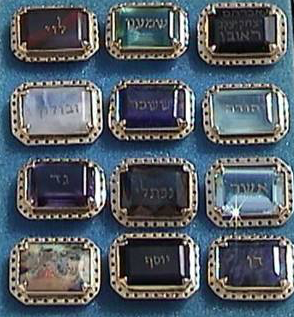
The only eye-witness account of the breastplate, outside of the Old Testament, is the written description of Josephus, a priest who served in his priestly duties in Herod’s Temple in Jerusalem. Josephus, Antiquities 3:7:1 – “Twelve stones were also on the breastplate, extraordinary in largeness and beauty; and they were an ornament not to be purchased by men, because of their immense value. These stones, however, stood in three rows, by four in a row, and were inserted into the breastplate itself, and they were set in (p)ouches of gold that were themselves inserted in the breastplate and were so made that they might not fall out. The first three stones were a sardonyx, a topaz, and an emerald. The second row contained a carbuncle, jasper, and a sapphire. The first of the third row was a ligure, then an amethyst, and the third an agate, being the ninth of the whole number. The first of the fourth row was a chrysolite, the next was an onyx, and then a beryl, which was the last of all. Now, the names of all those sons of Jacob, whom we esteem the head of our tribes, were engraved on these stones, each stone having the honor of a name in the order according to which they were born. There was also a girdle sewed to the breastplate. which was of the forementioned colors, with gold intermixed which, when it had gone once round, was tied again upon the seam and hung down.”
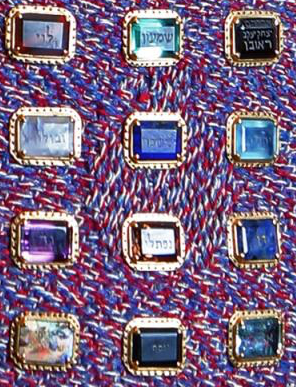
There are many opinions on what are the correct stones and the order for the stones. Listed below are a few of them.
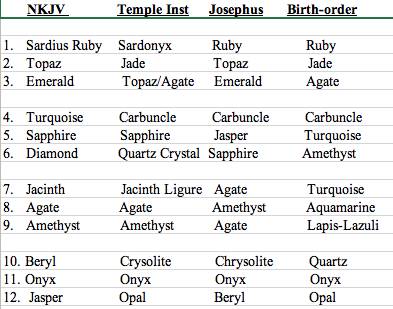

Best effort color determination of Breastplate Stone colors since some of the stones’ names have changed over time (Exodus 28:17-21. Exodus 39:10-14). Birth mother is indicated, and the birth order (Genesis 29:31-35. Genesis 30:1-24. Genesis 35:16-19).
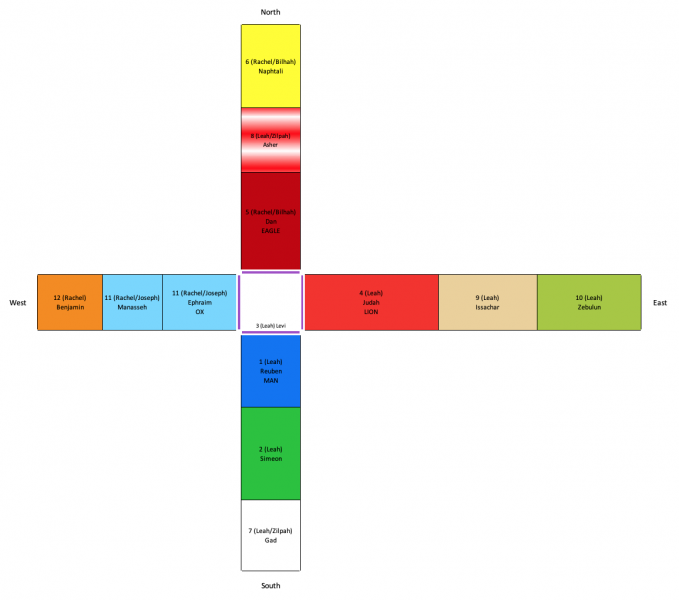
The figure above graphically depicts how Israel was instructed to camp (Numbers 2:1-34) with the width (East and West) or height (North and South) of each tribe corresponding to its population. This arrangement of the tribes forms a cross with its base to the East. There is some deviation from the Breastplate order as the tribe of Levi is in the middle of the camp around the Tabernacle, and the tribe of Joseph is replaced with his two sons Ephraim and Manasseh, effectively giving the tribe of Joseph a double portion in the promised land.
Spiritual Significance:
The precious stones with the names represented that all of God’s Special Treasures (i.e., His people) are on His heart. (Deuteronomy 7:6. Titus 2:14) The names were not simply written on the stones but rather engraved, meaning they can never be removed. This means that we are eternally secure in Jesus. Hallelujah! Realize precious stones are typically located deep within the earth. They must be diligently searched for with great determination, excavated, washed, and finally cut and polished (1) by the master jeweler to release their true beauty. (Matthew 13:44) When God, who is light, looks upon us living stones in Christ, He sees reflected back His perfect light from the stones. This light reflects the righteousness of Jesus and does not expose our blemishes from sin but rather reflects the righteousness of Jesus, who is a forever brilliant, beautiful, shining, priceless, precious, and secure person! He is not disappointed or angry at us living stones but rather well pleased since we are holy and perfect in Jesus Christ! (1 John 1:5. 1 Peter 2:4,5. Hebrews 12:23) This is because we are hidden in Christ, so the perfect light only reflects the perfect work of Jesus in removing our sins. That is, God the Father looks at Jesus to judge Christians. Again, He assesses us in the light of His unique Son, Jesus. What He is is what we are in the sight of God. Consequently, it is NOT all about us but rather all about Jesus Christ; we are hidden in Him! We are hidden in Jesus, the PRECIOUS of God the Father (2 Peter 2:6), which makes us precious to Him! (1 Peter 2:9). These are the same precious stones in the Garden of God called Eden (Ezekiel 28:13), symbolizing when mankind was free from sin.
The preciousness of Jesus in the eyes of God the Father has been imputed to us even as His righteousness has been imputed to us. (1 Peter 2:9. 2 Corinthians 5:21) God our Father looks upon us with all the favor with which He looks upon His unique Son Jesus, whom He loves infinitely. Furthermore, the Lord clothes us with His own beauty, having imputed to us His sanctification. (1 Corinthians 1:30) The Father sees us in His Son, not apart from Him, with the glorious radiance of the One that is Altogether Lovely (i.e., Totally Desirable) shines upon us. (Song of Songs 5:16) We have been brought by Jesus, our Great High Priest, to the place where we have entered into the presence of God the Father. It is a place of unlimited grace (i.e., unlimited favor). No demand made upon that grace can delete it. For all time and eternity, we are the objects of the Father’s supreme affection, the recipients of His unlimited mercies (i.e., unlimited ability to meet all our needs, wants, and desires). (Romans 5:1,2. Hebrews 4:16) (5)
The Breastplate was attached to the Ephod by two solid gold chains on each side that were braided and twisted for double strength, meaning we are securely attached to our Great High Priest. On each side, one chain represents that we will never be snatched from God our Father’s hand, and a second chain represents we will never be snatched from our God Jesus’ hand. (John 10:28,29) Nothing can separate us from the love of God in Christ Jesus our Lord (Romans 8:38,39)
The Breastplate was also attached to the Ephod by one piece of blue wool yarn on each lower side. When Jesus cried out “FINISHED” from the cross, He only said one word in Aramaic: “KŪLÁH: Finished or fulfilled! (John 19:30) It is the verb form of the word “Complete.” This is the root word for “Tekhelet,” pronounced “te-KAY-let,” which was the blue tunic worn by the high priest. That word literally means “blue.” Consequently, the blue thread is another picture of the God who came from Heaven, our Lord, and Savior Jesus Christ, whose completed work is what holds us close to God our Father’s heart.
2. Ephod

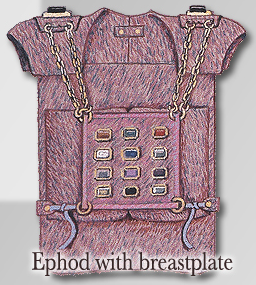
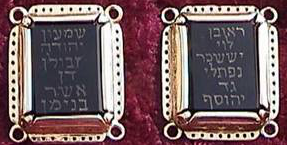
Pictured above: Memorial Stones with the names of the Twelve Tribes of Israel, which had the names of the sons of Israel (Jacob) according to their birth order and were placed on the shoulders of the ephod (Exodus 28:9-12. Exodus 39:6,7).
Spiritual Significance:
These stones represent that all the names of God’s Special Treasure (i.e., His people) and their needs are carried on His shoulders, representing being upheld by His strength. (Isaiah 9:6) They demonstrate that all believers, from the latest convert to the mature believer, are equally precious and complete in His sight. Also, the names were not simply written on the stones but rather engraved, meaning they can never be removed. This means that we are eternally secure in Jesus. Hallelujah!
Blue, purple, scarlet wool yarn, white linen thread, and pure gold thread of the ephod.
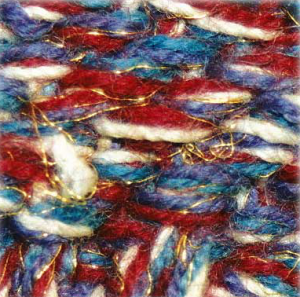
Pictured above: Blue, purple, and scarlet wool yarn, along with white linen thread and pure gold thread.
The most important garment worn by the High Priest is the ephod. Its appearance can be likened to an apron; it was worn in the back, on top of his other garments, and was fastened by a long belt in the front, opposite his heart. This belt was woven into the entire length of the ephod’s upper hem. There were also two shoulder straps that were sewn onto the belt. These straps went behind, up, and slightly over the garment’s upper corners, over the priest’s shoulders. The settings for the two sardonyx stones (i.e., memorial or remembrance stones) were attached at the ends of these straps on the shoulders. According to Josephus, the engraved onyx stones on the shoulders were designed so that the six eldest sons’ names were engraved on the stone on the right shoulder and those of the six youngest sons on the stone on the left shoulder. (3) The ephod covered the back of his body. It was long – it extended from just below his elbows all the way to his heels. It was slightly wider than a man’s back since it was to cover his back and extend a little towards the front on both sides as well, covering a portion of his belly from either side. Gold was beaten, pressed, and hammered into paper-thin sheets, then cut into tiny strips. These were then rolled and hammered some more until each piece was the tiniest, finest pure gold thread.
"They are to make the ephod of gold, blue, purple, scarlet, and fine twisted linen, the work of an artistic designer. It is to have two shoulder pieces attached to two of its corners, so it can be joined together. The artistically woven waistband of the ephod that is on it is to be like it, of one piece with the ephod, of gold, blue, purple, scarlet, and fine twisted linen. "You are to take two onyx stones and engrave on them the names of the sons of Israel, six of their names on one stone, and the six remaining names on the second stone, according to the order of their birth. You are to engrave the two stones with the names of the sons of Israel with the work of an engraver in stone, like the engravings of a seal; you are to have them set in gold filigree settings. You are to put the two stones on the shoulders of the ephod, stones of memorial for the sons of Israel, and Aaron will bear their names before the LORD on his two shoulders for a memorial. You are to make filigree settings of gold and two braided chains of pure gold, like a cord, and attach the chains to the settings. (Exodus 28:6-14 NET)
He made the ephod of gold, blue, purple, scarlet, and fine twisted linen. They hammered the gold into thin sheets and cut it into narrow strips to weave them into the blue, purple, and scarlet yarn, and into the fine linen, the work of an artistic designer. They made shoulder pieces for it, attached to two of its corners, so it could be joined together. The artistically woven waistband of the ephod that was on it was like it, of one piece with it, of gold, blue, purple, and scarlet yarn and fine twisted linen, just as the LORD had commanded Moses. They set the onyx stones in gold filigree settings, engraved as with the engravings of a seal with the names of the sons of Israel. He put them on the shoulder pieces of the ephod as stones of memorial for the Israelites, just as the LORD had commanded Moses. (Exodus 39:2-7 NET)
While the priestly garments were allowed to have a combination of wool and linen, those of the laity were not. Likely, this had to do with the sacredness of the priesthood’s garments and what these materials and colors represented typologically.
You must not wear clothing made with wool and linen meshed together. (Deuteronomy 22:11 NET) (cf. Leviticus 19:19; Ezekiel 44:17–18)
Spiritual Significance:
The making of the gold thread provides a glimpse into what our Jesus endured for our sakes when He was beaten, pressed, hammered, cut, bruised, and battered for our redemption. He took a merciless beating so we would not have to take one! (Isaiah 53:5. 1 Peter 2:24)
“Blue” speaks of Jesus’ Divinity as Very God having come down from Heaven the abode of God. It is also the color of grace. Before He was born of Mary, Jesus was “All God” or rather “All Blue.” I believe God made the sky blue to reflect the glory of His Son!
Purple is the color of Royalty. Jesus is the King of Kings and Lord of Lords! Note It is always mentioned second.
Scarlet, or red, is the last color mentioned. In Hebrew, the word for red is “Adam” or “Edom.” Adam one of the words for “man” and literally means “red-blooded man.” It is derived from the root word in Hebrew for blood: “Dam.” Red speaks of Jesus’ shed blood, The One Who became the second and last “Adam,” or “red or red-blooded man.”
White represents Jesus’ purity and righteousness, the legal foundation for our redemption. Notice that there are five components: Gold, blue, purple, scarlet, and linen. That’s the number of GRACE! Jesus, the one full of Grace and Truth!
Note the story told by the colors and their order: Blue – Jesus, who is God, came from heaven; Red – Jesus was born of a red-blooded human virgin to become the Son of Man. Purple – the God-Man (Blue+Red=Purple) Jesus, who is the Last Adam! No need for a third or more Adam as this one finished the work! That is, God became something He was not before. He used to be only “All God,” but now He is also “All man,” making HIm the Perfect Man! That means today, there is a real, live, beating human heart in Heaven representing you and me at the Father’s right hand. Jesus, our Great High Priest, has human emotions, understanding, and compassion. (Hebrews 2:17;4:15) He does not simply understand what we feel. He feels what we feel! When you and I accept Jesus as our personal Savior, we, the “red” of human birth, accept the “blue” of Christ’s divinity, and we become “purple,” too! We become like Jesus with the difference that we started out all red and He started out all blue (i.e., all God). Once you become purple, you can never become red again. That is, you cannot lose your salvation because the work of the Last Adam was greater than that of the First Adam! (John 10:28,29).
3. Robe (Tekhelet)
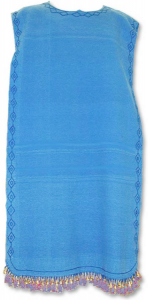
The Sky-Blue (the color of the sky at noon) robe or tekhelet (Hebrew) was a closed garment seamlessly woven from one piece of fabric and slipped on over the head. It was worn over the tunic; the tunic was longer than the robe by one handbreadth, so it was visible underneath the robe at the bottom. The garment hung down in front and in the back, and its length extended all the way down to the priest’s feet. The neck’s opening was round, with a hem that was doubled over and closed by weaving-not by a needle. Note the neck of this garment was specifically fortified to prevent it from accidentally tearing. Remember, it was customary in Israel to tear their garments and put sackcloth and ashes on their heads upon the death of a relative (Genesis 37:33,34). The High Priest’s garment was holy and sacred; therefore, not to be torn even for a relative’s death. (Leviticus 21:10. Leviticus 10:1-7) Furthermore, he could not go near any dead person, including his father and mother (Leviticus 21:11). That is, his personal emotions cannot overrule his ministry to represent people to God. However, at Jesus’ Sanhedrin trial, the High Priest Caiaphas (the name means rock) tore his clothes even though this was forbidden. (Matthew 26:62-65)
Spiritual Significance:
The Hebrew word “tekhelet” literally means “blue,” with its root word meaning “complete.” When Jesus cried out “finished” from the cross, He said one Aramaic word: “kulah,” translated as Teleostei in Greek, with both words meaning “finished” (6). Consequently, the blue robe represents that the finished work of grace completed by Jesus, our Great High Priest, will never end (i.e., not undone or torn). In Jesus’ statement, “It is finished,” we have a declaration of salvation that is both in a particular moment in time and eternity. Hallelujah! The robe is put on from above, meaning not self-appointed but rather office and authority God appointed (John 19:11).
The tearing of the priestly garments by Caiaphas represented the abolishment of the Levitical Priesthood and its replacement after the Melchizedek Priesthood order. (Psalms 110:4) Jesus was to become the eternal High Priest, our Great High Priest. Hallelujah! (Hebrews 5:6,10; 6:20) Even as the Levites were priests of the Old Covenant, we believers are all priests and kings after the order of Melchizedek and ministers of the New Covenant. Melchizedek’s name comes from two Hebrew words: Melchi, meaning King, and Zedek, meaning Righteousness. He was also the King of Salem, which means peace. (Genesis 14:18,20. Hebrews 7:1-17) Therefore, He is the King of Righteousness and Peace and a giver of righteousness that leads to peace with God the Father. (Romans 5:1,2)

Decorative pomegranates made of sky-blue, purple, and crimson-dyed wool were attached to the robe’s lower hem. These pomegranates were actually hollow spheres of fabric in the shape of pomegranates. Some believe that the bells and pomegranates were interspersed alternatively, in between each other; however, others hold that the bells were placed inside the pomegranates (the author of this article believes the latter). The robe’s hem was woven over double to prevent it from ripping due to the weight of the pomegranates and bells. Again, no sewing was used, simply weaving. Its threads were 12 plies.
"You are to make the robe of the ephod completely blue. There is to be an opening in its top in the center of it, with an edge all around the opening, the work of a weaver, like the opening of a collar, so that it cannot be torn. You are to make pomegranates of blue, purple, and scarlet all around its hem and bells of gold between them all around. The pattern is to be a gold bell and a pomegranate, a gold bell and a pomegranate, all around the hem of the robe. The robe is to be on Aaron as he ministers, and his sound will be heard when he enters the Holy Place before the LORD and when he leaves, so that he does not die. (Exodus 28:31-35 NET)
He made the robe of the ephod completely blue, the work of a weaver. There was an opening in the center of the robe, like the opening of a collar, with an edge all around the opening so that it could not be torn. They made pomegranates of blue, purple, and scarlet yarn and twisted linen around the hem of the robe. They made bells of pure gold and attached the bells between the pomegranates around the hem of the robe between the pomegranates. There was a bell and a pomegranate, a bell and a pomegranate, all around the hem of the robe, to be used in ministering, just as the LORD had commanded Moses. (Exodus 39:22-26 NET)
Spiritual Significance:
Pomegranates – a reminder that man’s (i.e., the First Adam’s) disobedience by partaking of the forbidden fruit (i.e., a pomegranate) from the Tree of the Knowledge of good and evil resulted in spiritual death (i.e., separation from God), thus requiring God to come from Heaven as a man born of a virgin (i.e., Jesus the Last Adam) to shed His Royal blood to pay the price for our redemption. (1 Corinthians 15:45,47)
Golden Bells – ringing out the good news that Jesus the Last Adam has paid the price of our sin from eating the forbidden fruit! We can now approach God and see His face without dying (Exodus 28:35) and not just His backside like Moses under the law. We are now at peace with God because Jesus has born the full judgment of God’s wrath for us! (Exodus 33:20-23. Romans 5:1;10:15. Ephesians 2:13-18. 1 John 3:2)
4. Plate

This diadem, crown, or headband was constructed with one piece of pure gold engraved with the simple message, “Holy to the Lord.” Unlike the crown worn by royalty on top of the head, this is worn across the forehead and extends from ear to ear. It was thin enough to arch across the forehead like a bow. Its width is approximately 4 cm (approximately 1.5 inches). It was always worn while the High Priest was within the Temple. The crown had three small holes: two on each end and one in the center located along the upper edge. Through these holes, threads dyed with Sky-Blue color were run, and the ends of these threads were connected in the back of the priest’s head. In this manner, the crown, itself a thin plate, was kept tied and in place on the High Priest’s forehead.
"You are to make a plate of pure gold and engrave on it the way a seal is engraved: "Holiness to the LORD." You are to attach to it a blue cord so that it will be on the turban; it is to be on the front of the turban, It will be on Aaron's forehead, and Aaron will bear the iniquity of the holy things, which the Israelites are to sanctify by all their holy gifts; it will always be on his forehead, for their acceptance before the LORD. (Exodus 28:36-38 NET)
They made a plate, the holy diadem, of pure gold and wrote on it an inscription, as on the engravings of a seal, "Holiness to the LORD." They attached to it a blue cord, to attach it to the turban above, just as the LORD had commanded Moses. (Exodus 39:30-31 NET)
Spiritual Significance:
The High Priest is also a King of Israel! As long as he wore the crown, his thoughts were considered pure.
5. Tunic
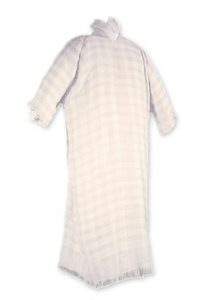
All the priests, including the high priest, wore a white linen tunic or kethoneth (Hebrew), a long-sleeved ankle-length garment. God first invented the tunic for Adam and Eve after they had sinned, and He made them from the skin of an animal, which I believe was a ram. (Genesis 3:21) However, the tunic was made out of very fine linen. Each garment was individually made from the finest white flax linen in Israel. It was made by “fine weaving,” in which there was no sewing except to sew on the arm sleeves. This “skillful weave” was not the routine cross-weave pattern found in most linen garments made from Israel’s looms. Rather, it was made into a weaving pattern of small boxes or cells or was diamond-shaped, giving it the appearance of a white-on-white honeycomb. Linen is a unique fabric that keeps the wearer cool in hot weather and warm when cold, which are efficient qualities for living in an arid climate with hot days and cold nights. The wearer of such linen made from breathable flax fibers would not sweat.
Jesus’ tunic was made from the finest linen and was completely seamless. It was this very expensive garment that the Roman soldiers gambled for at the foot of His cross. (John 19:23,24)
“You shall weave the tunic of checkered work of fine linen, and you shall make a turban of fine linen, and you shall make a sash, the work of a weaver. (Exodus 28:39 LSB)
They made the tunics of finely woven linen for Aaron and his sons, (Exodus 39:27 LSB)
They made tunics of fine linen – the work of a weaver, for Aaron and for his sons – (Exodus 39:27 NET)
"'When they enter the gates of the inner court, they must wear linen garments; they must not have any wool on them when they minister in the inner gates of the court and in the temple. Linen turbans will be on their heads and linen undergarments will be around their waists; they must not bind themselves with anything that causes sweat. (Ezekiel 44:17-18 NET)
Spiritual Significance:
White typifies righteousness and purity. Long sleeves were worn by privileged people, meaning they did not have to perform manual labor. That is, we have the righteousness of Jesus imputed to us based on His finished work and are now free from the impossible task of attempting to earn righteousness through our dead works (1). (Colossians 3:9,10. 2 Timothy 1:9. Titus 3:5. Ephesians 2:8,9. Romans 11:6) Hallelujah!
Sweat was part of the curse and represents human works, effort, reasoning, striving, worrying, fear, etc. (Genesis 3:19). God redeemed our sweat when Jesus’ great drops of sinless blood mixed with the great drops of the sweat of the second and last Adam, Jesus, in the second garden (Gethsemane). (Luke 22:44) He redeemed us from sweat produced from human works, effort, striving, worrying, fear, etc., and gave us His rest and peace! (John 14:27) We are to rest in Jesus’ completed work seated with Him (i.e., resting) in the Heavenly realms. (Ephesians 2:4-6) Hallelujah! This does not mean we are to sit around and do nothing all day. (2 Thessalonians 3:10) But rather this means as we go through our daily lives, we are to rest in Jesus, not worrying about what we shall eat, drink, or wear, etc. (Matthew 6:25-34)
6. Turban

Again, linen is a unique fabric that keeps the wearer cool in hot weather and warm when it is cold, which are very practical qualities for living in an arid climate with hot days and cold nights. The wearer of such linen would not sweat.
...make the turban of fine linen... (Exodus 28:39 b NET)
and the turban of fine linen, the headbands of fine linen, and the undergarments of fine twisted linen. (Exodus 39:28 NET)
You are to attach to it a blue cord so that it will be on the turban; it is to be on the front of the turban, (Exodus 28:37 NET)
They attached to it a blue cord, to attach it to the turban above, just as the LORD had commanded Moses. (Exodus 39:31 NET)
Spiritual Significance:
God desires His ministers to be even-tempered (i.e., cool-headed). The blue cord represents that Jesus’ mind is our mind (i.e., the mind of Christ). His thoughts are for us. God is not looking at my thoughts to judge me but rather the thoughts of the high priest. What Jesus is, we are in the sight of God. God, the Father, takes the holy and righteous thoughts of Jesus and imputes them to us. Again, what Jesus is – is what we are in the sight of God!
7. Sash

The ephod’s front and back were made to be as one garment by a sash or girdle, which was tied about the priest’s waist. This belt was made of a mixture of blue, purple, and scarlet wool yarn and white linen thread.
...make the sash the work of an embroiderer. (Exodus 28:39 c NET)
The sash was of fine twisted linen and blue, purple, and scarlet yarn, the work of an embroiderer, just as the LORD had commanded Moses. (Exodus 39:29 NET)
8. Undergarments
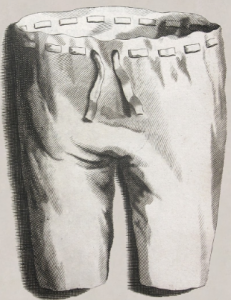
God invents boxer shorts! Again, linen is a unique fabric that keeps the wearer cool in hot weather and warm when cold, which are efficient qualities for living in an arid climate with hot days and cold nights. The wearer of such linen would not sweat. Note that God is concerned about covering our nakedness or private parts (Exodus 20:26. 1 Corinthians 12:20-24). Satan seeks to display them in a shameful, exploitative way, leading to a sense of vulnerability that approximates a fear of evil (Genesis 3:7).
Make for them linen undergarments to cover their naked bodies; they must cover from the waist to the thighs. These must be on Aaron and his sons when they enter to the tent of meeting, or when they approach the altar to minister in the Holy Place, so that they bear no iniquity and die. It is to be a perpetual ordinance for him and for his descendants after him. (Exodus 28:42,43 NET)
They made tunics of fine linen—the work of a weaver, for Aaron and for his sons—and the turban of fine linen, the headbands of fine linen, and the undergarments of fine twisted linen. (Exodus 39:27–28 NET)
Spiritual Significance:
God desires His ministers to have cool passions.
For this is God’s will: that you become holy, that you keep away from sexual immorality, that each of you know how to possess his own body in holiness and honor, not in lustful passion like the Gentiles who do not know God. (1 Thessalonians 4:3–5 NET)
The High Priest’s Day of Atonement Uniform

Only one time of the year did the High Priest wear white garments. That day was the highest and most holy day of the year, the Day of Atonement, a day also called the Day of Judgment. These garments are made from white linen (1), hence their designation “the white garments.” They must be woven, and each thread used must be six-ply woven from six individual strands of fabric.
This uniform consisted of four “White Garments”:
- Tunic (Long Shirt – Inner Garment)
- Turban (Hat or Mitre)
- Sash (Linen Belt or Girdle)
- Linen Leggings (Short Pants – Undergarments)
"In this way Aaron is to enter into the sanctuary– with a young bull for a sin offering and a ram for a burnt offering. He must put on a holy linen tunic, linen leggings are to cover his body, and he is to wrap himself with a linen sash and wrap his head with a linen turban. They are holy garments, so he must bathe his body in water and put them on. (Leviticus 16:3,4 NET)
Spiritual Significance:
The White Garments revealed Jesus as the Son of Man, the Last Adam, who stepped down from Heaven to become a servant and shed His blood for the original sin of the First Adam and everyone’s subsequent sins.
1. Tunic
The same as the High Priest’s Tunic previously described.
The High Priest wore two white tunics on the Day of Atonement. One he wore in the morning and the other in the evening. After the Day of Atonement’s conclusion, he will never again wear the white garments he officiated on this day. They are hidden in the place where he removes them.
"Aaron must then enter the Meeting Tent and take off the linen garments which he had put on when he entered the sanctuary, and leave them there. (Leviticus 16:23 NET)
2. Turban
Similar to the Priest’s Turban made of white linen and wrapped around the head.
3. Sash
This sash was made of only white linen thread.
4. Linen Leggings
The same as the High Priest’s undergarments previously described.
The Priest’s Year-round Uniform
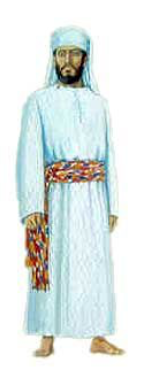
This uniform consisted of four garments:
- Tunic (Long Shirt – Inner Garment)
- Turban (Hat or Mitre)
- Sash (Linen Belt or Girdle)
- Undergarments (Short Pants – Linen Leggings)
"For Aaron's sons you are to make tunics, sashes, and headbands for glory and for beauty. "You are to clothe them– your brother Aaron and his sons with him– and anoint them and ordain them and set them apart as holy, so that they may minister as my priests. (Exodus 28:40,41 NET)
1. Tunic
The same as the High Priest’s Tunic previously described.
2. Turban
It is the same linen material as the High Priest’s Holy White Garments Turban previously described. It was donned by wrapping the head. It measures about ten centimeters wide and eight meters long (2.5 inches x 26 feet).
Moses also brought forward Aaron's sons, clothed them with tunics, wrapped sashes around them, and wrapped headbands on them just as the LORD had commanded Moses. (Leviticus 8:13 NET)
3. Sash
The same as the High Priest’s sash previously described.
4. Linen Leggings
The same as the High Priest’s undergarments previously described.
Spiritual Significance:
All believers are priests unto God and serve under the authority of the High Priest, Jesus the Messiah!
So as you come to him, a living stone rejected by men but chosen and priceless in God’s sight, you yourselves, as living stones, are built up as a spiritual house to be a holy priesthood and to offer spiritual sacrifices that are acceptable to God through Jesus Christ. (1 Peter 2:4,5 NET)
But you are a chosen race, a royal priesthood, a holy nation, a people of his own, so that you may proclaim the virtues of the one who called you out of darkness into his marvelous light. (1 Peter 2:9 NET)
From John, to the seven churches that are in the province of Asia: Grace and peace to you from “he who is,” and who was, and who is still to come, and from the seven spirits who are before his throne, and from Jesus Christ—the faithful witness, the firstborn from among the dead, the ruler over the kings of the earth. To the one who loves us and has set us free from our sins at the cost of his own blood and has appointed us as a kingdom, as priests serving his God and Father—to him be the glory and the power for ever and ever! Amen. (Revelation 1:4–6 NET)
You have appointed them as a kingdom and priests to serve our God, and they will reign on the earth.” (Revelation 5:10 NET)
Blessed and holy is the one who takes part in the first resurrection. The second death has no power over them, but they will be priests of God and of Christ, and they will reign with him for a thousand years. (Revelation 20:6 NET)
The Tabernacle of Moses Series:
- God’s Heavenly Pattern for our Spiritual Transformation – Part I: The Outer Court
- God’s Heavenly Pattern for our Spiritual Transformation – Part II: The Holy Place – Gold Lampstand
- God’s Heavenly Pattern for our Spiritual Transformation – Part III: The Holy Place – Table of Showbread
- God’s Heavenly Pattern for our Spiritual Transformation – Part IV: The Holy Place – Golden Altar of Incense
- God’s Heavenly Pattern for our Spiritual Transformation – Part V: The Most Holy Place
- God’s Heavenly Pattern for our Spiritual Transformation – Part VI: The Priestly Garments
- God’s Heavenly Pattern for our Spiritual Transformation – Part VII: Our Great High Priest
- God’s Heavenly Pattern for our Spiritual Transformation – Part VIII: The Women of the Tabernacle
Sacrifices and Offerings of the Old Covenant Series:
- The Fire Sacrifices and Offerings of Israel – Introduction
- The Fire Sacrifices and Offerings of Israel – The “Whole” Burnt Offering
- The Fire Sacrifices and Offerings of Israel – The Meal Offering
- The Fire Sacrifices and Offerings of Israel – The Peace Offering
- The Fire Sacrifices and Offerings of Israel – The Sin Offering
- The Fire Sacrifices and Offerings of Israel – The Trespass Offering
- The Fire Sacrifices and Offerings of Israel – The Red Heifer Offering
- The Fire Sacrifices and Offerings of Israel – The Ordination Offering
Shalom
(Security, Wholeness, Success)
Peace
Then he said to them, “Therefore every expert in the law who has been trained for the kingdom of heaven is like the owner of a house who brings out of his treasure what is new and old.” (Matthew 13:52 NET)
(1) Select the link to open another article with additional information in a new tab.
(2) http://www.templeinstitute.org/high-priest-garments-gallery.htm
(3) Ut supra. (Antiqu. l. 3. c. 7. sect. 5.)
(4) Depicted is a Temple service with the “kohane blessing” ritual (duchenen in Yiddish) that is performed on certain holy days. The actual blessing is done with both arms held horizontally in front, at shoulder level, with hands touching, to form the Hebrew letter “shin.” This stands for the Hebrew word for “Shaddai,” meaning “Almighty [God].”
(5) Wuest’s Word Studies From the Greek New Testament for the English Reader, Volume Three, Golden Nuggets, Kenneth S. Wuest, Reprinted 1999, ISBN-13: 978-0802822802
(6) “It is finished or completed” is the translation of the Greek word Tetelestai, which only appears twice in the Bible (John 19:28,30). Jesus says Tetelestai here in the perfect tense, which is very rare in the New Testament and has no English equivalent. The perfect tense is a combination of two Greek tenses: the Present tense and the Aorist tense. The Aorist tense is punctiliar, meaning something that happens at a specific point in time, a moment. The present tense is linear, meaning something that continues into the future and has ongoing results/implications. The combination of these two tenses in the perfect tense is used in John 19:30 is of overwhelming significance to the Christian. When Jesus says, “It is finished” (or completed), what He is actually saying is, “It is finished and will continue to be finished.” The first element of the perfect tense, the Aorist, punctiliar, point in time statement “It is finished” is powerful. Mathew Henry describes all that is finished at that exact moment in time: “It is finished; that is, the counsels of the Father concerning his sufferings were now fulfilled. It is finished; all the types and prophecies of the Old Testament, which pointed to the Messiah’s sufferings, were accomplished. It is finished; the ceremonial law is abolished; the substance has now come, and all the shadows are done away. It is finished; an end is made of transgression by bringing in everlasting righteousness. His sufferings were now finished, both those of his soul and those of his body. It is finished; the work of man’s redemption and salvation is now completed.” The Aorist tense is only half of the perfect tense! The second element of Jesus’ statement is equally important: the Present, ongoing, linear “and will continue to be finished” component of the perfect tense. This indicates the ongoing nature of our salvation. This is so important because it indicates a condition, a state of being, a resting place. In conclusion, in Jesus’ statement, “It is finished,” we have a declaration of salvation that is both in a particular moment in time and eternal, Aorist and Present, linear and punctiliar. We are saved at a specific point in time, “it is finished,” our debt is paid, we are ransomed from the kingdom of darkness, and then we confidently rest in the reality that “it will continue to be finished” because we are in a position of grace and stand justified for all time before God. One Greek word, Tetelestai, is spoken in the perfect tense by Jesus on the cross, and it was finished at that moment and for all time. (http://www.ciu.edu/content/it-finished-look-greek)


